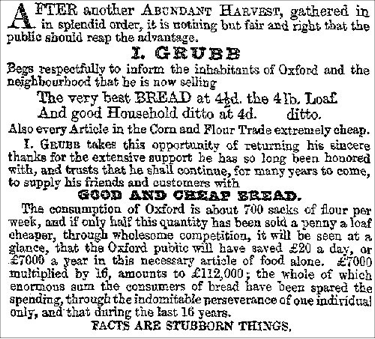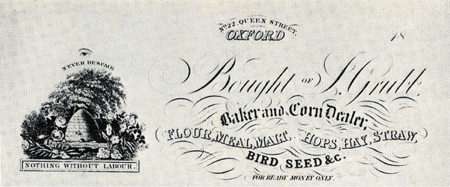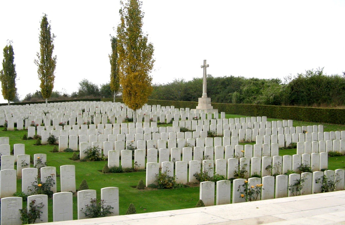Kindly emailed to me by Brother Anthony Porter of the De La Salle Brothers, some years ago (pba/9.8.15):
"A History of
Somerville House
130 Banbury Road
Oxford
My thanks to
Brother David Scarpa, for his interest in Somerville House, and for his suggestion that I try to find out something of its history;
Brother Anthony Brunning for doing some research for me in the Oxfordshire History Centre, and for the cover photograph;
Patricia Dingwall Thompson; Isaac Grubb (Senior) who lived in Somerville House from the late 1850s to 1880 was an uncle of her great-great grandfather Isaac Grubb, Junior, the son of Thomas Grubb;
Stephanie Jenkins, for her permission to reproduce her biography of Isaac Grubb from her website on the Mayors of Oxford, and for her assistance in extending knowledge of the Grubb family by doing some research in Oxford libraries;
[www.headington.org.uk/oxon/mayors/1836_1962/grubb_isaac_1857.htm]
Philip Archer, a grandson of William Archer who lived in Somerville House from 1923 to 1954, with particular thanks for the business career of William Archer and for the photographs of the family, the house and the gardens;
A number of other individuals, who have provided items of information.
Brother Anthony Porter,
Clayton Court
Rogate Road
Hill Brow
LISS
GU33 7QP
December 2011
Origins of the House
It seems probable that the house was built in the 1850’s, possibly by the architect Samuel Lipscomb Seckham. It does not appear on the 1851 census, but is clearly there on the 1861 census, occupied by Isaac Grubb.
Wikipedia has the following on Samuel Lipscomb Seckham:
“Samuel Lipscomb Seckham (25 October 1827 – 4 February 1900) was an English Victorian architect, developer, magistrate and brewer. He was born in Oxford, England, and became the City Surveyor. He was the original architect employed by St John’s College, Oxford to develop parts of North Oxford. He developed Park Town, an early and prominent estate in North Oxford. Through Seckham's efforts, the Park Town Estate Company was formed in September 1857. Such was the success of Park Town, he also worked on plans for Walton Manor and Norham Manor.
Seckham developed Bletchley Park, which he purchased in 1877 and sold in 1883 to Sir Herbert Samuel Leon (1850–1926), a financier and Liberal MP. Bletchley Park later became famous for the World War II codebreaking effort there.
In 1889, Seckham purchased and occupied Whittington Old Hall, a 16th century mansion house at Whittington near Lichfield in Staffordshire. He became High Sheriff of Staffordshire in 1890. He also held the office of Deputy Lieutenant (DL).
Seckham married Kinbarra Sweene Smith and had a daughter Kinbarra Swene Seckham. There is memorial panelling for Seckham in St Giles Church at Whittington.”
I have also taken a look at the adjoining site which is now taken up by Cunliffe Close. It was originally occupied by a house called Summer Villa, later re-named Cherwell Croft, for which Seckham was the architect, as described by Peter Howell (a writer on Victorian architecture, especially in Oxford) in an article in Oxoniensia in 1976 on S L Seckham:
“Seckham's other known architectural work does not add up to much. As far as North Oxford was concerned, he was architect and surveyor to another speculative project, the Tontine, set up in 1855, which built Summer Villa on Banbury Road. About 35 acres of land at Summertown were to be bought from Mr. Mark Horn (a Summertown shopkeeper and bacon curer). The land was subject to a charge of £10 a year to New College, and was within a mile of the City centre, with a 668 ft. frontage to Banbury Road. The intention was to erect a ‘family residence’ with drawing room, dining room, library, six principal bedrooms, offices, and also coach-house, stabling, farm buildings, and entrance lodge. A contract had been made with Messrs. Robert Castle and Co., builders, to complete the buildings by Midsummer 1856. They were then to be leased for seven years to the highest bidder. The house was rather curiously built right in the north-west corner of its very extensive site, presumably so that it would have the widest possible view over its wooded grounds. Italianate in style, and stuccoed, its principal feature was a semi-circular bow. It later became Greycotes School, and was demolished about1970, except for the lodge and some of the offices. (Its site is now occupied by Cunliffe Close).”
Robert Castle is mentioned as the builder of Summer Villa. The following, although predominantly about his son James, does provide some background information:
James Castle (1829/30-after 1891) was the son of Robert Castle, builder and architectural sculptor of Cowley Road, Oxford in 1851, who was described as a sculptor, but seems to have been mainly an architect. James was born in Toddington, Gloucestershire, though his father came from Woodstock. In Oxford directories his addresses are in Iffley Road (1864) and Thames Street (1869). He worked on churches in Oxfordshire and held the impressive sounding post of Engineer of the Upper Thames. He was linked with the Petworth area from 1857, when he designed Byworth school. Others named Castle in Oxford in the building trade are probably connected. After 1869 James Castle underwent a change of career, for in 1881 he was living in Paddington and called himself an architect and journalist. Ten years later, the transition was complete, for whilst still in Paddington, he called himself journalist/author only. Neither he nor his wife is to be found in the 1901 census, suggesting that he was dead by then.
Mark Horn (mentioned as the person who sold the land to the builder/developer of Summer Villa) is on the 1851 census in Oxford St. Giles District 12d, described as “all that part in St. Giles called Summer Town including all Summer Town, Mr. Cripps Farm, and all houses in the fields, all cottages at Hayfields Hutt (the Public House and Cottage excepted) bounded west by Port Meadow, north by Watereaton, east by the River Cherwell and south by Oxford.” [This is not very helpful is describing the location of Mark Horn’s property!]
Summer Villa does not appear on any of the censuses from 1861 to 1911 (the latest available, as they are released only after 100 years). From the description in Peter Howell’s article and an inspection of the available maps, it is my opinion that the name Summer Villa was changed to Cherwell Croft by 1900. On the 1st edition Ordnance Survey map (which for Oxfordshire was produced 1872/1880) the house is named Summer Villa, but on the 2nd edition O.S. maps onwards (1897/1900 for Oxfordshire) it is named Cherwell Croft; also, it clearly appears as Cherwell Croft in the 1901 census.
The Oxfordshire History Centre’s online catalogue has only one entry for Somerville House, as follows:
Somerville House, 130 Banbury Road, Oxford
Double fronted villa, possibly by S. L. Seckham, circa 1850
Two stories front, three stories rear with cellar
SP 50 NW OXFORD BANBURY ROAD 24/668 No 130 Somerville House. II
On front elevation, 2 12-pane sash windows at ground floor level and 3 12-pane sash windows at first floor level. Entrance porch with Grecian Doric columns in stone and pilasters behind. Full entablature and 3- stepped podium. Slated roof, hipped at east and west ends and central valley. 2 chimney stacks on east elevation, 2 to north and 1 to west. Listing NGR: SP5101008600
Record type Building
Monument type Site : Villa 1830 - 1870 (c. 1850)
Reference number PRN 26885
Status Listed Building, grade II
Parish/district: Oxford, Oxford, Oxfordshire
Grid reference SP 51010 08600
The Grubb Family
Somerville House was almost certainly built in the 1850’s. Isaac Grubb was Mayor of Oxford in 1857/1858, and so he was a prominent citizen of the city. He was living in the house at the time of the 1861 census, and so it is likely that it was built for him, and almost certainly he was the first occupant.
From censuses, electoral registers, and registration of births, marriages and deaths, I have been able to build up a Family Tree for the Grubb family covering their time at 130 Banbury Road, with a little before and after. This is attached.
Isaac Grubb: Mayor of Oxford 1857/1858
Isaac Grubb (1807–1885) was a baker and corn dealer who used to boast that he had never done a “penn’orth of business” with the colleges. He was also a prominent Baptist at New Road Baptist Chapel.
Grubb was born on 26 November 1807, the son of Thomas Grubb of St Peter-le-Bailey parish in Oxford, who had married Sarah Anderson, a minor, at Newington near Wallingford on 7 November 1796. They had the following children:
Thomas Grubb (brought to St Peter-le-Bailey Church on 20 June 1798)
Elizabeth Grubb (born on 29 July 1802, with birth recorded in the register of New Road Baptist Chapel nine years later in 1811)
Isaac Grubb (born on 26 November 1807, with birth recorded in the register of New Road Baptist Chapel four years later in 1811).
Isaac’s parents were described as being of St Peter-le-Bailey parish in 1811.
On 16 May 1833, when he was 25, Isaac Grubb married Elizabeth Taman at St Clement’s Church. The marriage was announced thus in Jackson’s Oxford Journal on 18 May 1833:
On Tuesday last was married, at St. Clement’s Church, by the Rev. J. W. Hughes, Rector, Mr. Isaac Grubb, baker, corn and flour factor, Queen-street, to Elizabeth, eldest daughter of Mr. Taman, St. Clement’s.
In about May 1834 their daughter Elizabeth Taman Grubb was born, but her mother died soon after childbirth. The following notice appeared in Jackson’s Oxford Journal of 21 June 1834:
On Thursday last died, in the 25th year of her age, Elizabeth, wife of Mr. Isaac Grubb, corn factor, Queen-street, and eldest daughter of Mr. Taman, St. Clement’s.
Despite being a Baptist, on 10 July 1834 Isaac had his daughter Elizabeth baptised at St Clement’s Church when she was just two months old, which implies that the motherless baby was probably ailing; and indeed just four days after the ceremony she was buried in St Clement’s churchyard.
In the 1830s Isaac Grubb was one of the group from New Road Baptist Church instrumental in purchasing land in the Croft in Headington to build a new Baptist Chapel there, and it may have been in connection with this that he met his second wife, the Headington widow Mrs Sarah Anne Hiern. She and Grubb were married on 28 January 1837 at St Peter-le-Bailey Church; both of them were then aged about 30.
Grubb entered civic life in July 1837 when he was appointed Guardian for St Peter-le-Bailey parish, and in June 1843 he was appointed Chairman of the Board of Guardians of the Oxford United Parishes.
At the time of the 1841 census Grubb (33) was living over his shop at 22 Queen Street with his wife Sarah, a girl named Mary Grubb, five baker’s shopmen, and one servant. Mary Grubb was Isaac’s niece, the daughter of his brother Thomas. The birth of Mary Ann Grubb on 18 October 1828 was registered at New Road Baptist Church; she was the daughter of Thomas & Mary Grubb, who had moved to Oxford from Wantage in about 1825, eventually settling in St Ebbe’s. Isaac, who was childless, obviously took a big interest in her family; indeed, her younger brother Robert James Grubb, born in 1840, eventually took over his business.
Grubb was first elected on to the City Council for the South Ward in November 1841, despite the fact that he was regarded as a joke candidate. Jackson’s Oxford Journal, reported on 30 October 1841:
Mr. Grubb, of Queen-street (of radical notoriety) has suffered himself to be drawn late into the field as a candidate, but without the most distant chance of success – in fact his starting is looked on quite as a joke, and has caused considerable merriment in the Ward.
Grubb’s brother Thomas died at the beginning of 1847. His death was reported thus in Jackson’s Oxford Journal: “Jan. 22, quite suddenly, in the 49th year of his age, Mr. Thomas Grubb, of St. Ebbe’s, in this city.” His widow must have fallen on hard times, as she was working as a straw bonnet maker by 1851.
In 1850 Grubb complained that it was impossible for a dissenter to become mayor, sheriff, alderman, or magistrate in Oxford (but just three years later in 1853, he and John Towle were chosen as Oxford’s first nonconformist aldermen).
At the time of the 1851 census Grubb and his wife were still living over the shop at 22 Queen Street with a baker’s journeyman, a baker’s shopman, and one servant. Gardner’s Directory lists his business at this address, and adds “& at St. Clement’s” (where he also had a baker’s shop at No. 16). But he also had premises in St Ebbe’s, as this extract from Jackson’s Oxford Journal for 28 June 1851 shows:
Non-payment of Paving Rates: Isaac Grubb, baker, of Queen-street, was summoned for the non-payment of lighting and paving rates, and stated that his reason for not paying them was, because there was no light to his premises, which are situated in St. Ebbe’s-street, and that other premises paying less rates were lighted.
Grubb lost his case with the Lamp Committee, who deemed his passage and yard private property without a thoroughfare. He was soon summonsed again for not paying for lighting and paving for his properties in St Clement’s, St Ebbe’s, St Michael’s, and St Peter-le-Bailey parishes, and again lost his case.
Grubb never lost an opportunity to make a political point, as this advertisement, which he inserted in Jackson’s Oxford Journal for 20 September 1851, shows:

At a council meeting in April 1854 Grubb made another stand in support of nonconformity; after stating that he had “no connection with the University, and nothing for which to thank any member thereof”, he introduced a motion “to petition Parliament in favour of the admission of Jews, Turks, Roman Catholics, Infidels, Heretics, and Dissenters of every denomination to enjoy the advantage of education in the national Universities”.
Grubb was elected Mayor for 1857/8. He was well known for not putting up with “nonsense”, and refused to have “that bauble”, namely the city mace, carried before him when he attended Carfax Church. He also stood up for Town against Gown. W.E. Sherwood records in Oxford Yesterday (1927) what happened on 10 February 1858, St Scholastica’s Day, when Grubb was expected to humiliate himself before the University for the events of that day in 1355:
The City, too, was still to a great extent under the control of the University …. A mayor, Mr. Isaac Grubb, greatly daring, when summoned with the Corporation to attend the annual sermon at St. Mary’s on St. Scholastica’s day - a sermon putting the town in what was considered its proper place, and for which, as an additional insult, they paid the fee - had
‘Stated in emphatic language
What he’d be before he’d stand it.’
Whether it was the vigour of his refusal which scared them, or whether it was that the University thought it was about time that a quarrel of five hundred years ago should be forgotten, we know not, but at any rate the summons was not pressed, nor was it renewed.
The city had contributed to the upkeep of the city church (St Martin’s at Carfax) since at least 1579, but Grubb refused to pay the then yearly contribution of £35 on the grounds that any contribution from city funds towards a church was contrary to the Municipal Reform Act. He also refused to go to Court to present an address of congratulation to Queen Victoria because he would have had to wear court dress, and he had no mind “to make a Tomfool” of himself.
At some point between 1851 and 1861 Isaac Grubb moved out of 22 Queen Street, which was henceforth occupied by his brother Thomas’s widow and her family. Grubb’s nephews Isaac Grubb junior and Robert Grubb then ran the shop there. Isaac Grubb senior moved up to a much grander house in Summertown: Somerville House (now 130 Banbury Road). At the time of the 1861 census (four years after his term of office as Mayor), Grubb (53) can be seen living at Somerville House with his wife Sarah (whose age has shrunk to 45), his niece Sarah Bateman (11) of Headington, plus just one servant. He was then described as a Magistrate & Corn Dealer, Baker & Mealman.
By 1867 Grubb evidently had gone against his own principles and had started doing business with the colleges, because animosity towards him during the Bread Riots of that year arose from the fact that he sold his bread more cheaply to the colleges than to the public.
In 1871 Grubb still lived at Somerville House with his wife, and in addition to Sarah Bateman, another niece, Alice May Bateman, aged 14, was living with them. These were the daughters of the Headington stonemason James Bateman and his wife Mary Ann, and so are probably the nieces of his second wife, Sarah, rather than his own. None the less Sarah is described as his adopted daughter in her marriage announcement in Jackson’s Oxford Journal of 15 July 1871:
July 6, at the Congregational Chapel, Summertown, by the Rev. O. Brand, Mr. J.H. Williams, University House, High-street, Oxford, to Sarah Anne Bateman, the adopted daughter of Alderman and Mrs. Grubb, Somerville House.
Grubb’s nephew Isaac emigrated to America; but Robert James Grubb was still living at the old business premises at 22 Queen Street in 1879. By the end of 1880, however, Robert Grubb had moved up to live in his uncle’s home in Summertown, Somerville House; meanwhile Isaac Grubb had moved with his wife Sarah to a smaller more central house at 37 Beaumont Street. Sarah died here at the age of 73 near the beginning of 1881, and that year's census shows Isaac Grubb as a widower and described as a retired corn merchant; he was then living alone at 37 Beaumont Street with three servants (a cook, a general servant, and a coachman). Grubb died at the age of 76 on 23 March 1885, and his funeral was at Headington. His obituary in The Times of 3 April 1885 reads as follows:
The death is announced of Mr. Isaac Grubb, of Oxford, in his 77th year. Deceased took a prominent part in the Anti-Corn Law agitation, and also in the movements for the repeal of the Test and Corporation Acts, the abolition of church rates, the removal of the paper duty, and the reform of Parliamentary and municipal institutions. During his public life in Oxford Mr. Grubb frequently found himself in hostility to the University. When overseer of one of the Oxford parishes he appealed to the Law Courts in favour of the permanent rating of the University and was successful. When elected as mayor in 1857 he declined to take the customary oath of submission to the University, which custom was subsequently abolished. Mr. Grubb, as a strong Liberal, long took an active part in the politics of the city.
A month after his death Grubb’s executors advertised in Jackson’s Oxford Journal of 25 April 1885 the forthcoming auction of three of his properties: the Sherborne Arms on the corner of St Ebbe’s Street and Queen Street; a freehold shop at 45 St Ebbe’s Street occupied by Mr Brindley, and finally his own Beaumont Street home:
LEASEHOLD FAMILY RESIDENCE. No. 37, Beaumont Street, Oxford, with excellent Twin Stall Stable and Coachhouse, with small Garden and Walled-in Yard, approached by a separate entrance from St John Street.
Grubb’s executors put in another advertisement on 9 May 1885 describing his furniture, to be sold by auction on the premises of 37 Beaumont Street.
Grubb’s nephew, Robert James Grubb, appears to have inherited Somerville House, which is given as his address when he was proposed to represent the South Ward first on the new County Borough Council in October 1889 and then in the municipal elections in October 1891. He also took over his uncle’s business: an advertisement dated 7 September 1887 shows that Grubb’s old business (now called R.J. Grubb) had branches at 15 St Aldate’s and the Castle Mills in addition to 22 Queen Street and 16 St Clement’s. As well as selling bread, it was the “best establishment in Oxford for poultry and horse food”, with crushed corn for horses that was “unequalled in Oxford or elsewhere”. Robert James Grubb was still living at Somerville House in 1915. He died at the age of 81 in 1921.

Above is Isaac Grubb’s engraved bill-heading. “Never Despair”, with an eye drawn above it, and below it is a beehive with a second motto reading “Nothing without labour”. The rest of the bill heading reads:
No. 22 Queen Street, Oxford, 18–
Bought of I. Grubb
Baker and Corn Dealer
Flour meal mart, hops, hay, straw, bird seed, &c.
For ready money only
See also:
- Jackson’s Oxford Journal, 28 March 1885, p. 5c: Obituary
- Jackson’s Oxford Journal, 8 May 1858 re Mayor’s oath to the University
- Oxford Mail, 4 November 1983, p. 5 and 31 January 1984 about the possibility of naming a street after him
- Michael L. Turner and David Vaisey, Oxford Shops and Shopping. A Pictorial Survey from Victorian & Edwardian Times (Oxford: B.H. Blackwell, 1972), page 27 for a comparison of the engraved bill-heading of Isaac Grubb with the jobbing printing of the hand-bill issued by his nephew R.J. Grubb in 1887
- 1841 Census: Oxford (St Peter le Bailey), 181/15
- 1851 Census: Oxford (St Peter-le-Bailey), 1728/482
- 1861 Census: Oxford (St Giles), 894/101
- 1871 Census: Oxford (Summertown), 1436/4
- 1881 census: Oxford (St Mary Magdalen), 1502/16
- British Listed Buildings: Somerville House
- Free BMD: death registration of Robert J. Grubb in Headington District (included Summertown) and of Sarah Ann Grubb in Oxford District
Birth, Marriage Death and Census information on the Grubb Family
Pre-1837 Baptism Records (mostly International Genealogical Index)
The following are the children of William Bateman and Susannah, all baptised in Headington, Oxfordshire:
Richardborn 26 December 1800 baptised 28 December 1800
Elizabeth born 13 January 1803baptised 16 January 1803
Johnborn 4 April 1804baptised 29 April 1804
Maryborn 18 August 1805baptised 13 October 1805
Sarahborn 8 July 1807baptised 6 September 1807
Hannahborn 11 July 1810baptised 2 September 1810
Williamborn 6 January 1812baptised 2 February 1812
Annbaptised 2 February 1815
James *baptised 2 February 1815 *
Jamesbaptised 15 September 1817
[* I presume that this James died in infancy; hence the next one having the same name]
Elizabeth Grubb baptised New Road Chapel, Oxford, 29 July 1802
Isaac Grubb baptised New Road Chapel, Oxford, 26 November 1807
both of parents Thomas Grubb and Sarah
Thomas Grubb married Mary Millichamp on 13 October 1822 in Wantage, Berkshire
Sarah Ann Bateman married Maurice Henry Hiern on 15 Sep 1826 in Stoke Damerel, Devon
Information from Stephanie Jenkins [responsible for the website on the Mayors of Oxford]:
Both Mary [Ann] Grubb (living with Isaac in 1841) and Robert James Grubb (who took over the business) were the children of Thomas & Mary Ann Grubb. Here are their children:
Sarah Grubb, born 8 September 1823 in Wantage, Berkshire (Wantage may be significant, see below)
Mary Ann Grubb, born 17 November 1826 in St Michael's parish, Oxford
Thomas Randle Grubb, born 17 November 1826
William Grubb, born 14 March 1828 in St Ebbe's parish, Oxford (died aged 10 months, buried 22 May 1829)
William Henry Grubb, born 15 August 1830 in St Ebbe's
John Grubb, born 7 May 1833 in Witney (died St Ebbe's aged 2yrs 9mths, buried 8 Feb 1836)
[New Road Baptist Church records stop there, but 1841/1851 census shows following additional children at home with Thomas & Mary in St Ebbe's]
Isaac Grubb (born Oxford 1836/7)
Robert James Grubb (born Oxford 1841/2)
Elizabeth Grubb (born Oxford 1844/5)
The father Thomas had died by 1851 and the mother obviously struggling to make ends meet, as she was working as a straw bonnet maker. Isaac obviously helped out with the children.
I suspect that the reason that I can't find Isaac's baptism in Oxfordshire was that he was born in Wantage (then in Berkshire), or somewhere in that area.
[See also further details in Stephanie Jenkins’s information on the life of Isaac Grubb as Mayor of Oxford 1857/1858]
Birth, Marriage and Death Registrations
Births
Robert James GrubbOxford1840
Milcah PayneAbingdon 1847
Elizabeth L GrubbDewsbury 1914
Arthur Page GrubbDewsbury 1915 - 27 July
Veronica Rosemary Grubb Dewsbury 1918 - 30 May
Ann MomirovichNuneaton 1950
Susan MomirovichAtherstone 1952
Marriages
James Bateman and Mary Ann Hitchins Cirencester1841
Edwin Payne and Milcah FowlerChipping Norton 1843
Mary Anne Grubb and William Belcher Bennett Oxford1845
Elizabeth Grubb and John WilceOxford1869
Sarah Anne Bateman and JH Williams Congregational Chapel, Summertown, Oxford
6 July 1871
Robert James Grubb and Milcah Payne Abingdon1873
Madeline Grubb and William Anderson Headington1903
Robert Walter Grubb and Gertrude Ellis West Ham, Essex 1909
Sidney Edwin Grubb and Jane(t) E Eldrid Oxford1912
Eileen Nancy Grubb and Stanko Momirovich Atherstone1950
Deaths
Thomas GrubbOxford1847
William BatemanHeadington 1849
Susannah BatemanHeadington 1852
Mary GrubbOxford1871aged 67
Isaac GrubbOxford1885aged 77
Robert James GrubbHeadington 1921aged 81
Milcah Grubb (née Payne) Headington 1923aged 76
Robert W GrubbDewsbury 1958aged 81
Arthur Page GrubbCarlisle 1983aged 68
Veronica Rosemary Grubb Halifax1999aged 80
Census Records
1841 census : living at Church Street, Oxford

1841 census : living at 22 Queen Street, Oxford

[+ 6 bakers as lodgers]
1841 census : living in High Street, Headington, Oxfordshire

[I think that John and William Simmons were relatives (grandchildren?); see Joseph Simmons living with James Bateman and his family in 1851]
1841 census : living at New Road, Oxford

[This is Thomas Randle Grubb]
1851 census : living at Abingdon, Berkshire

1851 census : living at Church Street, Oxford

1851 census : living at 22 Queen Street, Oxford

1851 census : living at High Street, Headington, Oxfordshire

1851 census : living in High Street, Oxford

1861 census : living at Colham House, Colham Green, Hillingdon, Middlesex

[George Kemp’s family and other pupils are included on the full census listing]
1861 census : living at Queen Street, Oxford

1861 census : living at Somerville House, Banbury Road, Oxford

1861 census : living in New Headington, Oxfordshire

1861 census : living at 34 Corn Market Street, Oxford

1871 census : living at the Baker’s Shop, 22 Queen Street, Oxford

1871 census : living at Banbury Road, Oxford

1881 census : living at Somerville House, Banbury Road, Oxford

1881 census : living at 37 Beaumont Street, Oxford

Will of Isaac Grubb
On 17th day of April 1885 the Will of Isaac Grubb, late of 37 Beaumont Street in the City of Oxford, gentleman, formerly an Alderman of the said City, deceased, who died on the 23rd day of March 1885 at 37 Beaumont Street aforesaid, was proved in Her Majesty’s High Court of Justice in the District Registry attached to the Probate Division thereof at Oxford by the oaths of Robert James Grubb of Queen Street in the city of Oxford, Corn Merchant, the nephew of the deceased, and William Fowler (in the Will named Fowler) Payne of Abingdon in the county of Oxford, Miller, the executors named in the said Will.
Dated the 23rd day of April 1885
Personal Estate Gross£ 6,808 - 2 - 9
Personal Estate Net£ 6,763 - 6 - 4
This is the last Will and Testament of me, Isaac Grubb, of the city of Oxford, gentleman, late one of the Aldermen of the said city. I direct the payment of my just debts, funeral and testamentary expenses as soon as may be after my decease. I appoint my nephew Robert James Grubb and my friend Fowler Payne of Abingdon, Miller, executors of this my Will ..... I give and devise my messuage or dwellinghouse and premises in the Parish of St. Clement in the city of Oxford in which my niece Mary Anne Bennett now resides with the appurtenances thereto, and my freehold messuage called Somerville House with the garden, land and appurtenances situate at Summertown in the Parish of St. Giles now in the occupation of the said Robert James Grubb unto and to the use of my said nephew Robert James Grubb, his heirs and assigns for ever. I give and bequeath the following legacies, videlicet:
To my nephew William Bateman of New Headington one hundred pounds;
To my niece Alice Smith, now in New South Wales, one hundred pounds;
To my nephews Henry Bateman and Isaac Bateman the sum of fifty pounds each;
To the children of my late nephew James Bateman the sum of twenty five pounds each;
To my nieces Anne Bateman, Eliza Bateman and Fanny Bateman fifty pounds each;
To John Snow, William Snow and Rose Snow, sons and daughter of Dan Snow of Headington Quarry, mason, fifty pounds each;
To my nephew William Simmonds, now in London, the sum of fity pounds.
I give and devise all those my messuages or tenements, gardens, land and the respective appurtenances thereto in Wellington Square, Oxford, unto my niece Mary Anne Bennett absolutely, but if she dies before me then I give the same premises to such of her children as may survive me absolutely.
I give the two messuages and premises in New Inn Hall Street, Oxford, unto my niece Sarah Anne, the wife of Horace Williams, for her life, the rents to be for her sole and separate use free from the debts, control or interference of her husband, and her receipt alone to be a good discharge; and after her death I give the same premises between her two children, Lilian Mary and Sarah Elizabeth Williams, absolutely equally as tenants in common.
I devise all the rest of the real estate to which I shall be entitled at my decease, and I bequeath the residue of the personal estate to which I shall then be entitled [to my executors upon trust to sell my real and leasehold estates] and to convert and get in my residuary and personal estate ..... and to divide the proceeds of the sale ..... and all other my personal estate into nine shares and I give:
One of such shares to each of the four children of my late sister Elizabeth Steane, namely, Joseph Steane, Louisa Steane, Emily Jane Perrin and Sarah Amy Gray;
One share equally between the children of Samuel Edward Tyrell Steane, another child of my sister who is now dead;
One share unto William Grubb, one of the children of my late brother Thomas Grubb;
One share equally between the children of Elizabeth Wilce, who was a child of my late brother Thomas Grubb;
One share to the three children of my late nephew Isaac Grubb, equally;
One share equally Thomas Grubb and Sarah Grubb, the son and daughter of my nephew Thomas Randle Grubb, or such of the said nephews and nieces or children of such said nephews or nieces as shall be living at the time of my death, except that if any of my said nephews and nieces die before me leaving issue such issue shall take the parents share.
And I direct that my executors shall place the shares of any of the before named legatees or residuary legatees who may be under age at my decease in the Post Office Savings Bank or in the funds or upon real security until they attain the age of twenty one years, and at their discretion apply the whole or such part as they or he shall fit of the annual income of the share to which any child shall for the time being be entitled for or towards the maintenance, education or advancement of such child, or to accumulate the same.
Lastly, I revoke all other Wills. In witness whereof I, the said testator Isaac Grubb, have to this, my last Will and Testament, set my hand this 21st day of February 1885.
Witnesses: William Henry Walsh, solicitor, Oxford
J.E Walsh, 16 New Inn Hall Street, Oxford, solicitor
Proved at Oxford, the 17th day of April 1885
1891 census : living at Somerville House, Banbury Road, Oxford

Extract from Summertown Houses and Personalities, page 47:
“Charles Titian Hawkins was surely the most remarkable character ever connected to Summertown. He appears first in Summertown records as attending Vestry meetings. In 1854 he was elected People’s Warden on the proposal of Owen Grimbly, and stayed in office until 1865 when Mr. Grimbly took his place. But he was back again as Vicar’s Warden in 1871 and thereafter he held office continuously until Easter 1895, making a total of 37 years as Warden, under six different Vicars. At the Vestry of 1893, Mr. R.J. Grubb did murmur something to the effect ‘that with Parish trust money to deal with it was unwise to leave the wardenship always in the same hands’ - a point he emphasised again in an open letter after the meeting. But everyone knows that Mr. Grubb was a notorious Dissenter and rather tactless in the way he exercised his rights as a ratepayer.”
Following that Vestry Meeting in 1893, Robert James Grubb wrote an open letter to his fellow parishioners, as follows:
Election of People’s Churchwarden, Summertown
8 April 1893
Fellow Parishioners
As very few of you could attend the Vestry Meeting last Tuesday, and might be relying upon the “Oxford Times” report of the meeting as truthful, permit me, as the Editor has singled me out as the chief offender, to place before you a correct statement of the facts. He intimates that Messrs. Grubb and Wheeler entered the Vestry after Mr. Waugh had proposed Mr. Brooks. We were there, and heard the Vicar appoint his Warden before Mr. Waugh began speaking.
Then, the paper says, I proposed Mr. Matthews, and I demanded a poll. It was not so : Mr. Wheeler proposed, and Mr. Wheeler demanded the poll. I am sure you like truth and fair play.
Then the Editor stigmatises me a “belligerent dissenter”, and asks if I would like Chapel meetings invaded by two or three Churchmen bent on “strife and disorder”. If they were members of that Chapel Society they would have a right to be there, the same as every Ratepayer has a right, no matter what his creed, to be at a Parish Vestry. As the expense of this Poll, will be but a few shillings, the Editor need not be anxious about the Vicar’s means.
The pity is that this Vestry Meeting, the only one in the year at which the parishioners have an opportunity of selecting their Warden, is generally held when it is impossible for any but well-to-do people to attend. A special opportunity will be given to you on Monday next to vote and choose the man you think will be your best friend. Don’t any of you throw this chance away.
Remember the chief duty of your Warden is to help distribute various moneys, and look after matters for the general welfare of all the Parishioners; and as one of the Charities to dispose of amounts to Thirty Pounds per year it is of first importance that you should deliberately select the right man for the office.
Yours truly,
Robert James Grubb
Banbury Road, Summertown
1901 census : living at Somerville House, 130 Banbury Road, Oxford

1911 census : living at 130 Banbury Road, Oxford

[Eleven rooms; married 37 years, 4 children, all still alive]
The third child of Robert and Milcah Grubb was killed in France towards the end the First World War, as the Commonwealth War Graves Commission website records:
In Memory of
Rifleman SIDNEY EDWIN GRUBB
41943, 8th Bn., West Yorkshire Regiment (Prince of Wales's Own)
who died age 37, on 25 May 1918
Son of Robert James and Milcah Grubb, of Oxford; husband of Jane E. Grubb,
of 316, Banbury Road, Oxford.
Remembered with honour
BAGNEUX BRITISH CEMETERY, GEZAINCOURT

Commemorated in perpetuity by
the Commonwealth War Graves Commission
Robert James Grubb died in 1921 and his widow Milcah in 1923.
Will of Robert James Grubb
Be it known that Robert James Grubb of 130 Banbury Road in the City of Oxford, retired Miller and Corn Dealer, who at the time of his death had a fixed place of abode at 130 Banbury Road aforesaid died on the 28th day of June 1921 at the Acland Road Nursing Home, Banbury Road.
And be it further known that at the date hereunder written the last Will and Testament of the said deceased was proved and registered in the District Probate Registry at Oxford, and that administration of the estate was granted to
Robert Walter Grubb of Somerville House, Claremont Road, Dewsbury, in the County of York, Borough Electrical Engineer, the son of the deceased, and Richard Henry John Bartlett of Lloyds Bank Chambers, Carfax, Oxford, Estate Agent, the Executors named in the Will.
Dated the 8th day of October 1921
Gross value of Estate£ 12,945 - 11 - 3
Net value of Personal Estate£ 4,863 - 19 - 2
This is the last Will and Testament of me, Robert James Grubb, of 130 Banbury Road, Oxford, retired Miller and Corn Dealer. I appoint my son Robert Walter Grubb and my friend Richard Henry John Bartlett of Lloyds Bank Chambers, Carfax, Oxford, Estate Agent, to be the Executors and Trustees of this my Will ..... I give to each of my children, namely, the said Robert Walter Grubb, Madeline Bertha Anderson and Lillian May Danby the legacy of one thousand pounds. Provided always and I hereby declare that there shall deducted from each such legacy of one thousand pounds any advances which I have made to either of my said children during my lifetime, my intention being that such advances shall be brought into account as part of my estate and debited against the recipients thereof in winding up my estate.
I give to my dear wife Milcah Grubb the legacy of one hundred pounds to be paid to her immediately after my decease. All the rest of my estate I give to my Trustees upon trust at their discretion, in such manner and at such times as they shall think fit, to sell and to convert the same into money, or such parts thereof as shall not consist of money ..... And also to carry on any business in which I may be engaged at the time of my death ..... And then upon trust to pay the whole of the income of my residuary estate to my wife for her life. And after the decease of my wife I give the legacy of one hundred pounds to my grandchild Eileen Nancy Grubb, the daughter of my deceased son Sidney Edwin Grubb, and subject thereto I direct that my Trustees shall divide my residuary estate equally between my three children, namely the said Robert Walter Grubb, Madeline Bertha Anderson and Lillian May Danby. I desire to put it on record that during the lifetime of my deceased son Sidney Edwin Grubb I assigned to him the goodwill and book debts of the business of a Baker and Corn Dealer carried on at 34 Cornmarket Street, Oxford, and gave and delivered to him the stock in trade and effects belonging thereto, and in consideration thereof I have not made any further provision for his child, the said Eileen Nancy Grubb, than the said legacy of one hundred pounds ..... As witness my hand this 14th day of December 1920.
Witnesses : Henry F Gilpin, solicitor, Oxford
May Birt, 130 Banbury Road, Oxford, domestic servant
On the 8th day of October 1921, probate of this Will was granted at Oxford to Robert Walter Grubb, the son, and Richard Henry John Bartlett, the executors.
Will of Milcah Grubb
Be it known that Milcah Grubb of 130 Banbury Road in the City of Oxford, Widow, heretofore wife of Robert James Grubb, who at the time of her death had a fixed place of abode at 130 Banbury Road aforesaid died on the 22nd day of August 1923 at 130 Banbury Road aforesaid.
And be it further known that at the date hereunder written the last Will and Testament with a Codicil thereto of the said deceased was proved and registered in the District Probate Registry at Oxford, and that administration of the estate was granted to
Robert Walter Grubb of Claremont Road, Dewsbury, in the County of York, Electrical Engineer, the son of the deceased, the surviving executor named in the Will. Richard Henry John Bartlett, the Executor named in the said Codicil, having duly renounced the Probate and execution of the said Will and Codicil.
Dated the 7th day of March 1924.
Gross value of Estate : £7,838 : 17 : 10
Net value of Personal Estate : £7,636 : 9 : 7
This is the last Will and Testament of me Milcah Grubb of 130 Banbury Road, Oxford, the wife of Robert James Grubb, Corn Dealer and Miller. I appoint my sons Robert Walter Grubb and Sidney Edwin Grubb to be the Executors and Trustees of this my Will.
I give and bequeath my jewellery as follows:
To my son Robert Walter Grubb and his wife Gertrude Grubb ..... my mother’s gold watch and chain ..... gold brooch with his grandfather’s photograph at the back .....
To my son Sidney Edwin Grubb and his wife Janet Grubb ..... plain gold locket engraved “M.P.” ..... [Milcah Payne ? - Milcah Grubb’s mother]
To my daughter Madeline Bertha Anderson ..... oblong gold brooch with her father’s photograph at the back .....
To my daughter Lilian May Danby .....
I give and bequeath my silver and plated articles and household furniture and effects unto my said Executors and Trustees upon trust to allow my said husband Robert James Grubb the use thereof during his life. And upon the decease of my said husband, I give and bequeath the articles hereinafter named to my sons and daughters, namely
To my son Robert Walter Grubb one silver cake basket (once uncle Fowler Payne’s) ..... one silver snuff box (my father’s) ..... one large picture of his father (oak and gilt frame), one photograph of his mother (gilt frame) ..... three plated large forks marked “R.M.G.” .....
To my son Sidney Edwin Grubb ..... three plated large forks marked “R.M.G.” .....
To my daughter Madeline Bertha Anderson ..... two silver serviette rings marked “R.J.G.” “M.G.” [Robert James Grubb and Milcah Grubb ? Madeline’s parents] ..... two oil paintings of her grandfather and grandmother ..... three plated large forks marked “R.M.G.” .....
To my daughter Lilian May Danby ..... four large silver forks marked “P” ..... five small silver forks marked “P” ..... one silver serviette marked “2” ..... three plated large forks marked “R.M.G.” .....
[Who is “R.M.G.” ? - and who is “P” ?]
And on the death of my said husband I direct my said Executors and Trustees to divide the rest of my silver and plated articles and household furniture and effects not hereinbefore specifically mentioned equally between the said Robert Walter Grubb, Sidney Edwin Grubb, Madeline Bertha Anderson and Lilian May Danby. And all the rest, residue and remainder of my estate, both real and personal and wheresoever situate, I give, devise and bequeath unto my said Executors and Trustees upon trust after payment thereout of my just debts, funeral and testamentary expenses and the death duties payable at my decease to divide the residue thereof between my said sons and daughters Robert Walter Grubb, Sidney Edwin Grubb, Madeline Bertha Anderson and Lilian May Danby. And I empower my said Executors and Trustees to sell, realise and convert into money any part of my said residuary estate for the purposes of this my Will. And I revoke all Wills heretofore made by me.
In witness whereof I have hereunto set my hand this 25th day of October 1915.
Signed by the testatrix Milcah Grubb
In the presence of Henry F. Gilpin, solicitor, Oxford
H. Bullock, his clerk
This is a Codicil to the within written Will of me Milcah Grubb, by which I gave devised and bequeathed the residue of my estate equally between my four children, namely Robert Walter Grubb, Sidney Edwin Grubb, Madeline Bertha Anderson and Lilian May Danby. Whereas the said Sidney Edwin Grubb is now deceased, I now revoke the gift, devise and bequest of my residuary estate as aforesaid and in place thereof I give to my granddaughter Eileen Grubb and her mother Janet Grubb the legacy or sum of one hundred pounds each free of duty. All the residue and remainder of my said residuary estate I give, devise and bequeath unto my three children in equal shares, name the said Robert Walter Grubb, Madeline Bertha Anderson and Lilian May Danby. I appoint my friend Richard Henry John Bartlett of Lloyds Bank Chambers, Oxford, as an Executor and Trustee of my Will. In all other respects I confirm my said Will. As witness my hand this 20th day of November 1921.
Signed Milcah Grubb
Henry F. Gilpin, solicitor, Oxford
R.H.J. Bartlett, Lloyds Bank Chambers, Oxford
(15 folios)
On the 7th day of March 1924 Probate of this Will with one Codicil was granted at Oxford to Robert Walter Grubb, the son, one of the surviving Executors.
It is hereby certified that the foregoing is a correct copy.
Dated this 11th day of March 1924.
[Milcah Grubb is on the electoral register for 1923 Spring, but there is no entry for 130 Banbury Road for 1923 Autumn and 1924 Spring.]
The Archer Family
From censuses, electoral registers, and registration of births, marriages and deaths, I have been able to build up a Family Tree for the Archer family covering their time at 130 Banbury Road, with a little before and after. This is attached.
Birth, Marriage and Death Registrations
Births
Archer, William George R : Wallingford, Oxfordshire, 1878
Marriages
William George R Archer married Elizabeth Gilder in 1902 in Headington, Oxfordshire
Deaths
Archer, William George R : Oxford 1969 (date of birth 7 October 1878)
Census Records
1881 census : living at Warborough, Oxfordshire

1891 census : living at 7 Tackley Place, Oxford

1901 census : living at 7 Tackley Place, Oxford

1911 census : living at 64 Kingston Road, Oxford

The electoral registers show the Archer family in residence at 130 Banbury Road from the 1924 Autumn register to the 1953-1954 register. There are no registers available for 1930-1931, 1931-1932, 1932-1933, 1936-1937, 1937-1938, 1938-1939, during the War years (they begin again in 1945), 1947-1948, 1948-1949.
I have been able to make contact with Philip Archer, a grandson of William George Reed Archer, and I asked him if he would be able to give me some information on his grandfather’s life. The following is his reply:
“How interesting! Somerville House has meant so much to me and to other members of the family. It has been an inspiration since I first got to know it in the middle to late 1940s, as William George Reed Archer's grandson. And I have done much work on the family history, starting, to some extent, with this inspiration.
My most recent return to 130 Banbury Road was on Wednesday 14th September 2011 when I was doing some work at the family history centre at Cowley, and I called before going there that morning and spoke to the gentleman who answered the door and to whom I had the presumption to ask if I could take some more photographs of the house and garden - having called previously in 1991. He kindly gave permission and even invited me in to see the hall and stairs where I recognized the big mirror on the mezzanine which allows you to see from the top landing, who is coming in at the front door!
William George Reed Archer's occupations were:
1894 to 1900 : clerk at his Uncle Albert Edwin Reed's paper mill at Raamsdonkveer in the Netherlands;
1900 to 1919 : promoted from clerk (at first) to manager (of how much, I am not sure) at his father-in-law (George Blake)'s house-furnishing business, based in Little Clarendon Street and/or a property close to Little Clarendon Street in St Giles;
1919 : Leaves Mr Blake and joins his uncle James Archer in the latter's carrier/removals business (founded by James Archer in 1857) based in Pembroke Street and at Park End Street;
When James Archer died in about 1925 he was the residuary beneficiary and became a relatively rich man, inheriting the business (Archer Cowley & Co) and turning it into a family business in the sense of employing his two sons as working directors and his three daughters as non-executive directors for the rest of his life (he died in 1969 aged about 91);
William Archer acquired 130 Banbury Road at the time of James Archer's death and employed a full-time gardener and at least two maids and a housekeeper; the garden was a wonderful place to visit;
William Archer moved from 130 Banbury Road to 19 Sandfield Road, Headington, Oxford, next door to us at 17 Sandfield Road. I had thought he moved in 1959, but perhaps it was 1954. Your information is no doubt better than my memory. He lived in retirement at 19 Sandfield Road until his death.
Previous owners of 130 Banbury Road were the Grubbs who, I believe, were corn millers - which might explain the mill-wheel-like circular 'stones' still set in the driveway outside the front door.
Hope this helps. My thanks to your religious order for allowing me to visit 130 Banbury Road in 1991 and 2011.
Kind regards,
Philip Archer.”
[The photographs on the following pages have been supplied by Philip Archer]
Somerville House and William Archer’s car
[I made contact with someone who, as a hobby, has compiled a register of Sunbeam cars, and he has kindly supplied me with the following information. WL 6464 was a 6-cylinder, 2-litre 16.9 horse-power Sunbeam. It was one of about 3,000 to 3,500 made between 1927 and 1930, some as open-tourers, some as two-seaters and some as saloons. The chassis price started at £425 and the whole car would have cost about £600. He has only one record of a Sunbeam with an Oxford 'WL' registration number and amazingly it is this car, WL 6464. Newly licensed on the 7th March 1929 and last known of as belonging to a D.A. Tait of Penn Road, Wolverhampton in 1951. It was chassis number 5190K with engine 5215K.]
(towards where 140 Banbury Road now stands)
Looking East from the front door of Somerville House towards Banbury Road
(with what may be Cherwell Croft behind the trees)
The drive towards Banbury Road
The Front Door of Somerville House
Somerville House rear garden and orchard
Wedding photograph of William Archer and Elizabeth Gilder in 1902
Philip Archer writes:
This is taken, I think, at the family's previous house at 64 Kingston Road,
only the length of St Margaret's Road and a little more, from Somerville.
William Archer is accompanied by
(in front) Nora
(second row, left to right): Olive or Gladys (identical twins), his sister Rose (I think), his mother (Olive Emma Reed Archer), and the other twin
The twins look about 6 to 8, so the year must be about 1920 to 1922;
that is, only a few years before they all moved to Somerville.
Greycotes School
On the electoral registers, the following is the information given for 130 Banbury Road:

From this table, I am assuming that Greycotes School acquired 130 Banbury Road about 1954, and some staff were resident there.
Planning permission for conversion of garage block into school laboratory, cloakroom and store, dated 16 December 1957; gymnasium dated 27 April 1960; change of use from residential to school purposes dated 17 August 1963
[I have made contact with the librarian/archivist of Greycotes School. Their archive material is packed up in boxes pending a move to another site; she will contact me when it is available.]
----------------------------------------
De La Salle Brothers
The Brothers purchased the three properties then known as 130 Banbury Road, 158 Banbury Road and 1 Marston Ferry Road in late 1966 from The Greycotes Properties Oxford for £83,000, with contracts exchanged on 22 December 1966.
Somerville House, 130 Banbury Road, was included “in the statutory list of buildings of special architectural or historical interest”. Notification came in a letter from the Department of the Environment dated 16 August 1983.